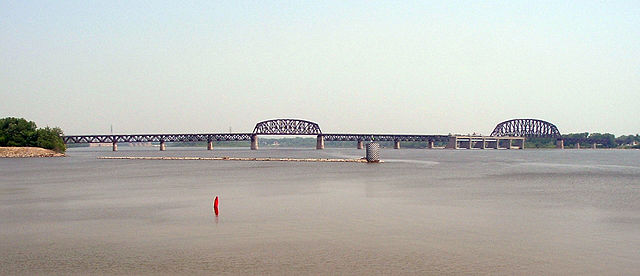The Kanawha River is a tributary of the Ohio River, approximately 97 mi (156 km) long, in the U.S. state of West Virginia. The largest inland waterway in West Virginia, its watershed has been a significant industrial region of the state since early in the 19th century.
The Kanawha River in St. Albans, West Virginia
Kanawha Falls on the Kanawha River at Glen Ferris, West Virginia.
The confluence of the Kanawha and Ohio Rivers at Point Pleasant, West Virginia
The Ohio River is a 981-mile-long (1,579 km) river in the United States. It is located at the boundary of the Midwestern and Southern United States, flowing in a southwesterly direction from western Pennsylvania to its mouth on the Mississippi River at the southern tip of Illinois. It is the third largest river by discharge volume in the United States and the largest tributary by volume of the north-south flowing Mississippi River, which divides the eastern from western United States. It is also the 6th oldest river on the North American continent. The river flows through or along the border of six states, and its drainage basin includes parts of 14 states. Through its largest tributary, the Tennessee River, the basin includes several states of the southeastern U.S. It is the source of drinking water for five million people.

The widest point on the Ohio River is just north of downtown Louisville, where it is one mile (1.6 km) wide. Indiana is on the right towards the flood gates, Kentucky on the left, towards the locks. The jetty on the left is the entrance to the Louisville and Portland Canal.
Steamboat Morning Star, a Louisville and Evansville mail packet, in 1858
Built between 1847 and 1849, the Wheeling Suspension Bridge was the first bridge across the river and a crucial part of the National Road.
Cave-in-rock, view on the Ohio (circa 1832, Cave-In-Rock, Illinois): aquatint by Karl Bodmer from the book Maximilian, Prince of Wied's Travels in the Interior of North America, during the years 1832–1834







